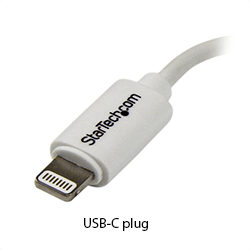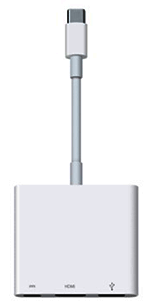Though Apple bases its Macs on original designs, it relies on lots of components invented by others–though it often uses the technology first and/or better than the competition. The USB-C connection, the only connector except for an audio jack on the new MacBook, is another example of Apple taking charge of a component.
USB-C, which refers to a specific small connector of the USB 3.1 standard, greatly increases the varieties USB can handle. For Apple the two big changes are to eliminate the need for power connections for charging (goodbye MagSafe!) and Thunderbolt for the support of high speed links including monitors and storage devices.
The main reason for the use of just USB-C appears to be the extreme limit of real estate in the new MacBook. The MacBook Air comes with a power connector, two USB 2.0 jacks, and a Thunderbolt 2 connector. But the tiny MacBook has little room either for external ports or space for components inside the battery-jammed case.
For a non-inventor, Apple has had a critical role in the adoption of USB. Development has been controlled by the USB Implementors Forum, led by Intel. The original 1.0 version was released in 1997. Intel insisted on its installation on PC motherboards and they sat there doing nothing for a year and a half. Then Apple came out with the first iMac, where the USB replaced the Apple Desktop Bus to replace mice, keyboards, printers, and other gear. Though the choice got heavy criticisms, it quickly proved wildly popular and replaced the mouse and keyboard connections, PS/2 connectors, printer sockets, and other connectors on Windows PCs.
 USB 2.0 and 3.0 produced significant improvements in speed, power output, and shrunken connectors. Version 3.1, released in 2013, came with new features including higher speeds, the capability to replace the Thunderbolt port (another Intel-led design), and the ability to take in power to charge a laptop battery. The USB-C plug replaces the cranky and fragile micro-USB connector with a new plug with a striking comparison to the tough and reversible Lightning plug used on the iPhone and iPad. I expect to see PowerBook competitors brag about the other connectors available on their products until they start redesigning them with just USB-C connections. We’ve been here before.
USB 2.0 and 3.0 produced significant improvements in speed, power output, and shrunken connectors. Version 3.1, released in 2013, came with new features including higher speeds, the capability to replace the Thunderbolt port (another Intel-led design), and the ability to take in power to charge a laptop battery. The USB-C plug replaces the cranky and fragile micro-USB connector with a new plug with a striking comparison to the tough and reversible Lightning plug used on the iPhone and iPad. I expect to see PowerBook competitors brag about the other connectors available on their products until they start redesigning them with just USB-C connections. We’ve been here before.
 Of course, the use of USB-C means users are going to have to spend a lot for new cables and adapters (I’m hoping for USB-C at Monoprice to drive prices down). The single port design like the Mac Pro makes it even worse. While various wireless services are reducing the need for cables, they don’t eliminate the requirement. Sometimes you need more than a single cable such as, say, power in and data out to a VGA projector.
Of course, the use of USB-C means users are going to have to spend a lot for new cables and adapters (I’m hoping for USB-C at Monoprice to drive prices down). The single port design like the Mac Pro makes it even worse. While various wireless services are reducing the need for cables, they don’t eliminate the requirement. Sometimes you need more than a single cable such as, say, power in and data out to a VGA projector.
Of course, though Apple has yet to ship the MacBook, it’s ready with the USB-C Digital AV Multiport Adapter. The handy device lets you feed a single USB-C port with an HDMI cable (mostly for connecting a TV or projector), USB 3.1 Gen 1 (handles older USB designs), and a second USB-C. Yours at an Apple Store for just $79, plus cables.

The connector photo captioned as USB-C appears to be a Lightning connector.
It’s a USB-C according to the advertiser. The fact is the USB-C and Lightning are similar, though the USB is a little thicker and wider.
There’s an excellent article about the MacBook’s USB-C on Ars Technica: http://arstechnica.com/apple/2015/03/explaining-the-usb-3-1-gen-1-port-in-the-retina-macbook/
Takeaway:
– the picture is indeed NOT a USB-C plug: USB-C plugs have the contacts inside a hollow connector, not outside of a solid connector ( http://www.extremetech.com/computing/187882-reversible-usb-type-c-connector-finalized-devices-cables-and-adapters-coming-soon ).
– USB 3.1 gen 1 (as in the new MacBook and the new ChromeBook Pixel) is just a rename of USB 3.0, nothing more nothing less.
– Every feature of the MacBook’s USB port (actually, every feature of USB 3.1 except the 10 Gbps “gen 2” speed which the MBP doesn’t support: power supply, 5.0 Gbps, video output) is part of the USB 3.0 spec. These features are optional in USB 3.0, and also optional in USB 3.1.
– The new connector confuses the issue, but the connector is separate from the USB version, and there has always been a lot of different USB connectors, that’s just one more.
In the end,
– the MacBook’s USB port could be also correctly be called USB 3.0.
– we’re entering a confusing period, computers with USB-C connectors and “USB 3.1” may or may not support specific features (charging either way, video, 10 Gbps…)
I think the admin of this site is really working hard for his website, since here every stuff is quality based data.
But wanna say that this really is quite helpful , Thanks for taking your time to write this.